1st week of school: Over 5 million children infected with COVID-19 in U.S.
- Normal Liver Cells Found to Promote Cancer Metastasis to the Liver
- Nearly 80% Complete Remission: Breakthrough in ADC Anti-Tumor Treatment
- Vaccination Against Common Diseases May Prevent Dementia!
- New Alzheimer’s Disease (AD) Diagnosis and Staging Criteria
- Breakthrough in Alzheimer’s Disease: New Nasal Spray Halts Cognitive Decline by Targeting Toxic Protein
- Can the Tap Water at the Paris Olympics be Drunk Directly?
1st week of school: Over 5 million children infected with COVID-19 in U.S.
- Should China be held legally responsible for the US’s $18 trillion COVID losses?
- CT Radiation Exposure Linked to Blood Cancer in Children and Adolescents
- FDA has mandated a top-level black box warning for all marketed CAR-T therapies
- Can people with high blood pressure eat peanuts?
- What is the difference between dopamine and dobutamine?
- How long can the patient live after heart stent surgery?
1st week of school: Over 5 million children infected with COVID-19 in U.S.
More than 5 million American children have been infected with COVID-19, a surge of 250,000 in the first week of school! CDC announces the distribution of sick and dead children

(Pandemic changes in the United States. Source: New York Times Epidemic Tracker)
The number of new cases in the United States continues to lead the world, with an average of more than 15,000 new cases per day and approximately 1,500 deaths.
The public has long been accustomed to COVID-19 cases, and it does not affect their lives.
Some people chose not to get vaccinated or wear masks, so they gave their lives to natural selection, or let them screen themselves for the new coronavirus.
It’s just that they pity their children. Schools in the United States have begun; no vaccine is available for children under 12 years of age.
According to a report by American Academy of Pediatrics, there were more than 250,000 new cases of COVID-19 among children in the United States just one week after school started.
The US Centers for Disease Control and Prevention (CDC) further announced the distribution of children who died of illness.
So let’s make an interpretation of these two sets of data.

First look at the basic information behind this set of data.
1) The time for this set of data analysis
Data for the week before September 2, 2021.
2) The age of the children in this set of data
The ages of children reported by the American Academy of Children are based on reports from various states. Most states are 17 years and younger, and some states are 19 years and younger. So the children in the data below are also in this age group.
3) Vaccination status.
The United States currently only opens vaccination for children 12 years and older.
Second, look at the summary of this set of data.
As of September 2, the United States has reported 5.04 million COVID-19 cases in children, accounting for 15.1% of all U.S. cases.
According to the census just completed in the United States, there are 75.26 million children in the United States; it is estimated that about 6.7% of American children have been infected with COVID-19.
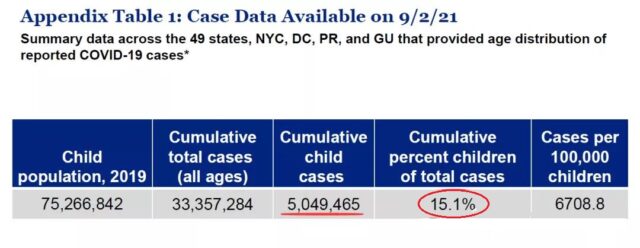
Among them, in the past week, there were 250,000 cases of COVID-19 in children in the United States, which also exceeded the number of cases of infection in children in the United States at the peak of the epidemic in January 2021.
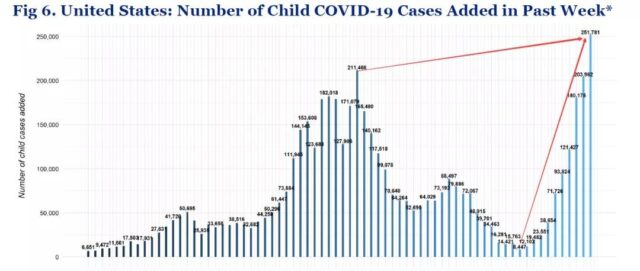
According to the analysis of Labor Day in the United States, the difference in epidemic prevention measures between various states in the United States is greater than the difference between different countries.
U.S. Labor Day: The number of infections is 4 times that of last year
The result has also led to a completely different situation of the epidemic situation and the situation of children with COVID-19 infection. In general, the northeastern United States has the highest vaccination rate and the epidemic is well controlled; while the southern United States has become the hardest hit area.
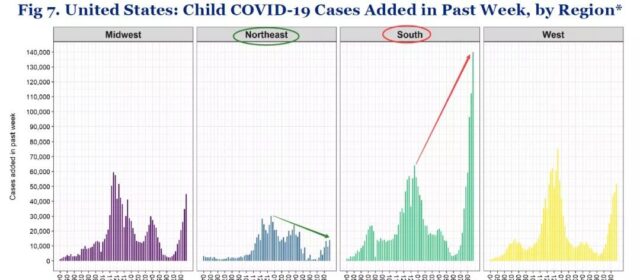
Due to the surge in child cases, child cases accounted for 26.8% of all COVID-19 cases in the past week.
This means that for every 4 newly confirmed cases, 1 is a child.
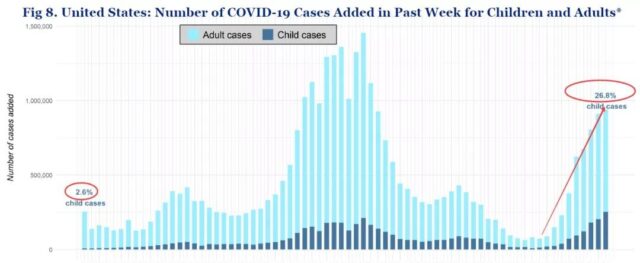
What we are most concerned about is, if a child is unfortunately infected with COVID-19, what is the severity of the illness, that is, the severity of the child’s COVID-19 and the fatality rate.
Let’s look at the situation in the last week.
Hospitalization rate
In the past week, COVID-19 cases among children in the United States requiring hospitalization accounted for 2.4% of all hospitalized cases, and the hospitalization rate was 0.9%. That is, for every 100 children infected with COVID-19, nearly 1 will be seriously ill and need to be hospitalized.
In this regard, the American Academy of Pediatrics mentioned worryingly:
There is an urgent need to collect more data on the long-term effects of the pandemic on children, including the ways in which the virus may harm the long-term physical health of infected children and its impact on emotional and mental health.

In the past week, COVID-19 deaths among children in the United States accounted for 0.07% of all deaths, with a case fatality rate of 0.01%. That is, for every 10,000 children who are infected with COVID-19, there will be one death.

In response to the situation of children who died of COVID-19, the US Centers for Disease Control and Prevention (CDC) announced the racial distribution, and we made a picture from this.
According to CDC statistics, a total of 486 children aged 18 and under in the United States died of COVID-19, of which 148 were children aged 0-4 and 338 were children aged 5-18.
According to ethnic distribution, among children aged 0-4, Latinos accounted for the largest number of deaths, accounting for 36%; the second was whites, accounting for 28%, the third was blacks, accounting for 22%, and Asians accounted for 2.7%.
The proportion of deaths among Hispanic children aged 0-4 is much higher than the proportion of their population; the proportion of deaths among white and Asian children is lower than the proportion of their population.
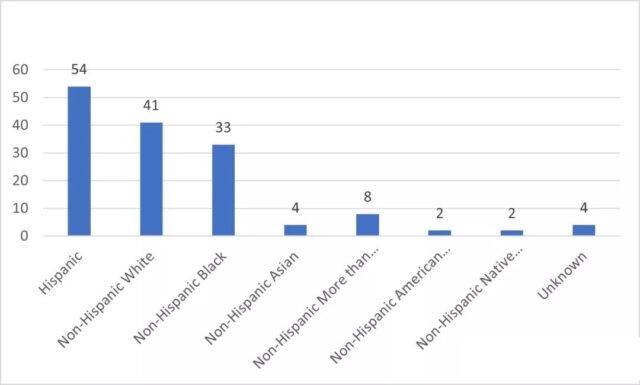
According to ethnic distribution, among children aged 5-18, Latinos accounted for the largest number of deaths, accounting for 35%; the second was whites, accounting for 33%, the third was blacks, accounting for 24%, and Asians accounted for 4.7%.
The proportion of deaths among Hispanic children aged 5-18 is much higher than the proportion of their population; the proportion of deaths among white children is lower than the proportion of their population.
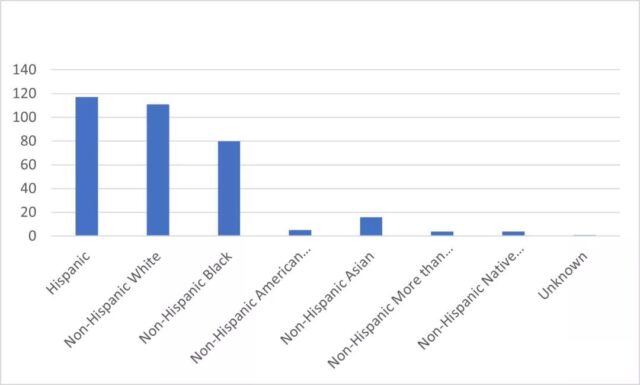
The ethnic distribution among children is consistent with the ethnic distribution of adults COVID-19 surveyed by Los Angeles County in the United States. Among the 43,127 adult patients with COVID-19 in the region, Hispanics accounted for the highest proportion of infected persons, accounting for 32.8%, the proportion of whites was 22%, and the proportion of Asians was 4.6%.
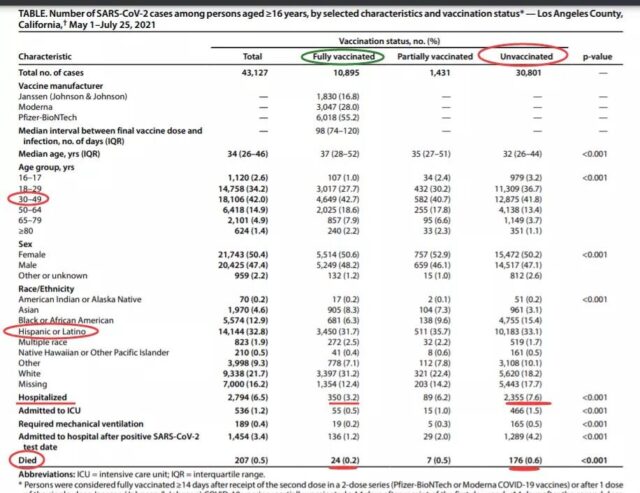
(Clinical characteristics of COVID-19 cases in Los Angeles)
Briefly summarize this set of data:
1. As of September 2, 2021, more than 5 million children in the United States have been infected with COVID-19; in the first week of school in the United States, there was a surge of 250,000 newly infected children with COVID-19, accounting for 26.8 of all new cases. %.
2. In the past week, the severe illness rate of children with COVID-19 in the United States was 0.9%, and the case fatality rate was 0.01%.
3. Further analysis by the US CDC shows that Hispanics account for 35% of children who died of COVID-19.
Family transmission is the most important source of infection for children with COVID-19, and there are more ways to transmit it to schools.
In this regard, Old Doctor Fauci babbled tirelessly:
“The way you protect children who, because of their age, cannot get vaccinated yet is to surround the children – be it friends, family, school teachers, personnel in the school – surround the children with vaccinated people,”
For children in school to prevent COVID-19, Dr. Kim, who is the director of the emergency department in a hospital in the United States, recommends: GET VACCINATED!
For children under 12 years of age, Dr. Kim’s advice is:
- Wear a comfortable mask (surgical mask is preferred) and prepare a mask;
- Eat as soon as possible when eating at school;
- Do not speak without wearing a mask.
(source:internet, reference only)
Disclaimer of medicaltrend.org
Important Note: The information provided is for informational purposes only and should not be considered as medical advice.



